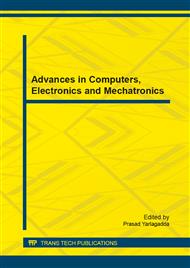[1]
KENNEDY J, EBERHART R C. Particle swarm optimization[C]/ Proceedings of IEEE International Conference on Neural Networks. Perth: IEEE Press, 1995: 1942 - (1948).
Google Scholar
[2]
WANG Hong-feng, WANG Ding-wei, HUANG Min. Forking PSO Algorithm for Dynamic Optimization Problems[J]. Journal of System Simulation, 2010,22(12):2895-2899.
Google Scholar
[3]
ZHANG, JIAJUN. A novel particle swarm optimization for image fusion[C]/ 2010 2nd International Asia Conference on Informatics in Control, Automation and Robotics, March 6-7, 2010, Wuhan, China: IEEE Computer Society Press, 2010: 126-129.
DOI: 10.1109/car.2010.5456644
Google Scholar
[4]
HAN Li, XIN Mao, LUO Ci-yong. Design of permanent magnet direct current motors based on a particle swarm optimization algorithm[J], Journal of Chongqing University(Natural Science Edition), 2009, 32 (5):535-538.
Google Scholar
[5]
KIM TAE-HYOUNG, ICHIRO MARUTA, TOSHIHARU SUGIE. Robust PID controller tuning based on the constrained particle swarm optimization[J]. Automatica, 2008, 44(4): 1104-1110.
DOI: 10.1109/cdc.2007.4434126
Google Scholar
[6]
ZHU JINRONG. A modified particle swarm optimization algorithm[J]. Journal of Computers, 2009, 4(12): 1234-1236.
Google Scholar
[7]
Kennedy J, Mendes R. Population structure and particle swarm performance[C]/Proceedings of IEEE Conference on the CEC 2002, Honolulu: IEEE Press, 2002: 1671−1676.
Google Scholar
[8]
LIANG JJ, QIN AK. Comprehensive learning particle swarm optimizer for global optimization of multimodal functions[C]/Proceedings of IEEE Conference on Evolutionary Computation, Singapore: IEEE Press, 2006: 281−295.
DOI: 10.1109/tevc.2005.857610
Google Scholar
[9]
YAO Jin-tao, ZHU Sheng-lin, ZHOU Min, etc. Particle Swarm Optimization with Predatory Escape Behavior[J]. Journal of System Simulation, 2010, 22(5): 1151-1154.
Google Scholar
[10]
J. Branke, T. Kaußler, C. Schmidth, and H. Schmeck. A multi-population approach to dynamic optimization problems. Proc. 4th Int. Conf. on Adaptive Computing in Design and Manufacturing, pp.299-308, (2000).
Google Scholar
[11]
D. Parrott and X. Li. A particle swarm model for track-ing multiple peaks in a dynamic environment using speciation. Proc. of the 2004 IEEE Congress on Evo-lutionary Computation, pp.98-103, (2004).
DOI: 10.1109/cec.2004.1330843
Google Scholar
[12]
T. M. Blackwell and J. Branke. Multi-swarm opti-mization in dynamic environments. In G. R. Raidl, ed-itor, Applications of Evolutionary Computing, LNCS 3005, pp.489-500, (2004).
DOI: 10.1007/978-3-540-24653-4_50
Google Scholar
[13]
T. M. Blackwell and J. Branke. Multiswarms, ex-clusion, and anti-convergence in dynamic environ-ments. IEEE Transactions on Evolutionary Computa-tion, 10(4): 459-472, (2006).
DOI: 10.1109/tevc.2005.857074
Google Scholar
[14]
J. Branke. Memory enhanced evolutionary algorithms for changing optimization problems. Proc. of the 1999 Congr. on Evol. Comput., vol. 3, pp.1875-1882, (1999).
Google Scholar
[15]
HE Ran, WANG Yong-Ji, WANG Qing, etc. An Improved Particle Swarm Optimization Based on Self-Adaptive Escape Velocity [J]. Journal of Software , 2005, 16(12): 2036-(2043).
DOI: 10.1360/jos162036
Google Scholar


